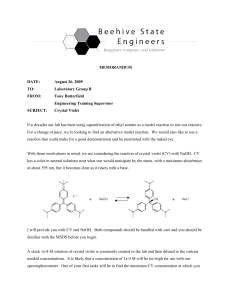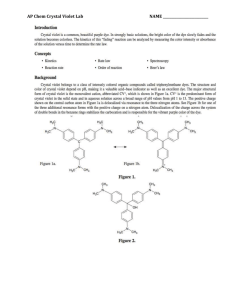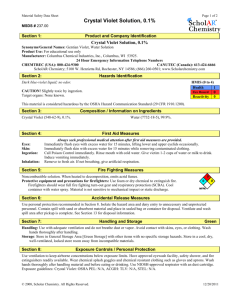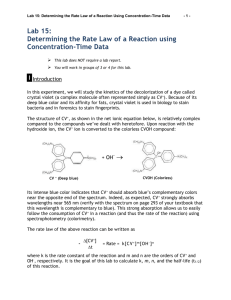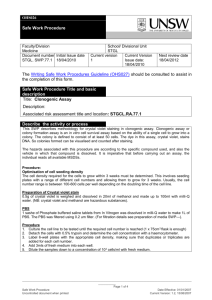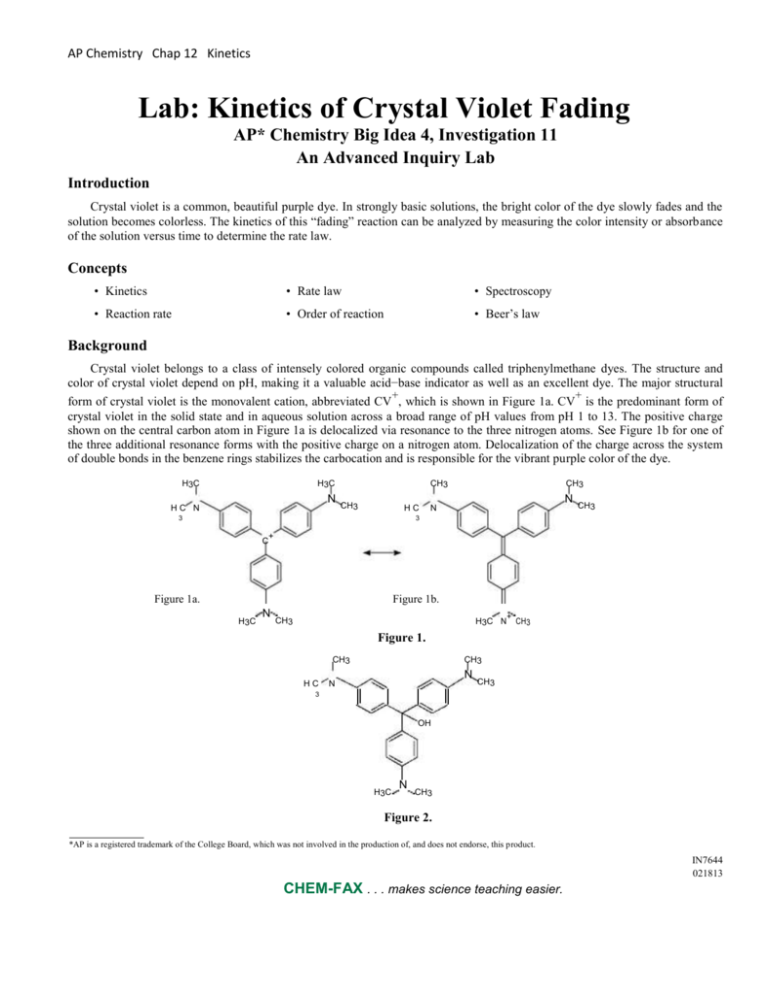
AP Chemistry Chap 12 Kinetics
Lab: Kinetics of Crystal Violet Fading
AP* Chemistry Big Idea 4, Investigation 11
An Advanced Inquiry Lab
Introduction
Crystal violet is a common, beautiful purple dye. In strongly basic solutions, the bright color of the dye slowly fades and the
solution becomes colorless. The kinetics of this “fading” reaction can be analyzed by measuring the color intensity or absorbance
of the solution versus time to determine the rate law.
Concepts
• Kinetics
• Rate law
• Spectroscopy
• Reaction rate
• Order of reaction
• Beer’s law
Background
Crystal violet belongs to a class of intensely colored organic compounds called triphenylmethane dyes. The structure and
color of crystal violet depend on pH, making it a valuable acid−base indicator as well as an excellent dye. The major structural
+
+
form of crystal violet is the monovalent cation, abbreviated CV , which is shown in Figure 1a. CV is the predominant form of
crystal violet in the solid state and in aqueous solution across a broad range of pH values from pH 1 to 13. The positive charge
shown on the central carbon atom in Figure 1a is delocalized via resonance to the three nitrogen atoms. See Figure 1b for one of
the three additional resonance forms with the positive charge on a nitrogen atom. Delocalization of the charge across the system
of double bonds in the benzene rings stabilizes the carbocation and is responsible for the vibrant purple color of the dye.
H3C
H3C
N
HC N
CH3
CH3
HC
3
CH3
N
N
CH3
3
C
+
Figure 1a.
Figure 1b.
H3C
N
CH3
H3C N
+
CH3
Figure 1.
CH3
HC
CH3
N
N
CH3
3
OH
H3C
N
CH3
Figure 2.
*AP is a registered trademark of the College Board, which was not involved in the production of, and does not endorse, this product.
IN7644
021813
CHEM-FAX . . . makes science teaching easier.
AP Chemistry Chap 12 Kinetics
+
In strongly basic solutions the purple CV cation slowly combines with hydroxide ions to form a neutral product, CVOH,
which is colorless (see Figure 2). The rate of this reaction (Equation 1) is slower than typical acid–base proton transfer reactions
and depends on the initial concentration of both crystal violet and hydroxide ions.
CV
+
–
+ OH → CVOH Equation 1 Purple Colorless
Exactly how much the rate changes as the reactant concentration is varied depends on the rate law for the reaction. In the
+
–
case of the reaction of CV with OH ion, the rate law has the general form
+n
–m
Rate = k [CV ] [OH ]
Equation 2
The exponents n and m are defined as the order of reaction for each reactant and k is the rate constant for the reaction at a
particular temperature. The values of the exponents n and m must be determined by experiment. If the reaction is carried out
under certain conditions then Equation 2 will reduce to the form
+n
Rate = kʹ [CV ]
Equation 3
–m
kʹ = k [OH ]
where
Equation 4
–m
The constant kʹ is a new “pseudo” rate constant incorporating both the “true” rate constant k and the [OH ] term. Equation 3 is
referred to as a pseudo-rate law because it is a simplification of the actual rate law, Equation 2.
−
+
The pseudo-rate law is valid when the concentration of OH ions is much greater than the concentration of CV ions. Under
−m
these conditions the [OH ] term in Equation 2 will not change much over the course of the reaction and may be treated as a constant in the rate equation.
Recall that the absorbance for a specific concentration of a solution with a fixed path length varies directly with the
absorptivity coefficient of the solution. This relationship is known as Beer’s law.
A = abc
Equation 5
where A is absorbance, a is the molar absorptivity coefficient, b is the path length in cm, corresponding to the distance light travels through the solution, and c is the concentration of the solution. Beer’s law provides the basis of using spectroscopy in
quantita-tive analysis. Using this relationship, concentration and absorbance may be calculated if one variable is known while
keeping a and b constant. This relationship is also extremely valuable in kinetics experiments, making it possible to follow the
rate of disap-pearance of a colored substance by measuring its absorbance as a function of time.
Experiment Overview
The purpose of this advanced inquiry lab activity is to use spectroscopy and graphical analysis to determine the rate law for
the color-fading reaction of crystal violet with sodium hydroxide. The lab begins with an introductory activity (laboratory technique) for constructing a calibration curve of absorbance versus concentration for the dye crystal violet. A series of known or
standard solutions is prepared from a stock solution of crystal violet and the absorbance of each solution is measured at an optimum wavelength. A Beer’s law plot of absorbance as a function of concentration may be used to calculate the concentration of
any “unknown” solution of the dye in a rate law experiment. The procedure provides a model for guided-inquiry design of experiments to determine the order of reaction with respect to both crystal violet and sodium hydroxide. Additional triphenylmethane
dyes, malachite green and phenolphthalein, are also available for optional extension or cooperative class studies.
Grading:
Prepare the Lab by: 1) reading the Introduction, Background and Experiment Overview.
2) Answering the Pre-Lab Questions.
Part I: Calibration data and graph
Part II: Questions 1 – 4
Part II: Procedure, Materials, Safety,
Part II: Data and Graph
Part III: Analyze the Results
Part IV: AP Review Questions
Total: 16 points
2 points
2 points
2 points
2 points
2 points
3 points
3 points
AP Chemistry Chap 12 Kinetics
Pre-Lab Questions
+
The visible absorption spectrum for crystal violet, CV , is shown in Figure 3. The concentration of the dye was 12.5 μM
–6
(12.5 × 10 M).
Absorption Spectrum for Crystal Violet
1.8
1.6
Absorbance
1.4
1.2
1
0.8
0.6
0.4
0.2
0 350
400
450
500
550
600
650
700
750
Wavelength (nm)
Figure 3.
1. What would be the optimum wavelength for generating a Beer’s law calibration curve for crystal violet and measuring absorbance
versus time for the reaction of CV+ with OH–? Explain your answer. Recall that absorbance measurements are most accurate
and sensitive in the range 0.2–1.0.
2. A calibration curve requires the use of several concentrations of the test solution. Using 25 μM CV solution as the stock solution,
complete the following table to show how you would prepare 2.5, 5, 7.5, 10, and 12.5 μM solutions of CV +. Assume that the
final solution volume should be 10.0 mL in all cases.
Table 1
Concentration
(micromolar, μM)
CV Stock
Solution
A
B
C
D
E
25 μM
2.5 μM
5.0 μM
7.5 μM
10.0 μM
12.5 μM
Water (mL)
Stock Solution
(mL)
0
5.0 mL
10.0
5.0 mL
3. Using your optimum wavelength for the experiment, predict the estimated absorbance value for each solution in Table 1.
Record these values in the table. Hint: Keep in mind Beer’s law from Equation 5 and the fact that the path length (b) and
wavelength are constant.
Materials
–5
Crystal violet solution, 25 μM (2.5 × 10 M), 50 mL (maximum amount to use)
Sodium hydroxide solution, NaOH, 0.02 M, 30 mL (maximum amount to use)
Cuvets or test tubes
Water, distilled or deionized
Pipet bulb filler
Beaker, borosilicate, 50-mL
Stirring rod
Pipet, serological, 10-mL
Spectrophotometer or colorimeter
Safety Precautions
Dilute sodium hydroxide solution is irritating to eyes and skin. Crystal violet is a strong dye and will stain clothes and skin.
Clean up all spills immediately. Wear chemical splash goggles, chemical-resistant gloves, and a chemical-resistant apron. Avoid
contact of all chemicals with eyes and skin and wash hands thoroughly with soap and water before leaving the laboratory. Please
follow all laboratory safety guidelines.
–3–
IN7644
© 2013 Flinn Scientific, Inc. All Rights Reserved. Reproduction permission is granted only to science teachers who have purchased Kinetics of Crystal Violet Fading, Catalog No. AP7644, from Flinn
Scientific, Inc. No part of this material may be reproduced or transmitted in any form or by any means, electronic or mechanical, including, but not limited to photocopy, recording, or any information
storage and retrieval system, without permission in writing from Flinn Scientific, Inc.
AP Chemistry Chap 12 Kinetics
Part I.
Laboratory Technique using a colorimeter to determine Concentration from Absorbance.:
Constructing a Calibration Curve for Crystal Violet
1. Turn on the spectrophotometer and allow it to warm up for 15–20 minutes before use. Adjust the wavelength setting to the
optimum wavelength determined in the Pre-Lab section.
2. Read the entire procedure before beginning and construct an appropriate data table to record measurements. Note: As part of a
cooperative laboratory activity, your instructor may assign different groups to prepare different solutions. Each group will need
to transcribe and analyze data for all of the solutions and resulting measurements in order to complete the guided-inquiry
activity.
3. Using a serological pipet for accuracy, prepare the series of standard dilutions of the crystal violet stock solution. Use the amounts
calculated in the Pre-Lab assignment. Lab Hint: To avoid contaminating the stock solution, first use the pipet to add the required
amount of distilled water to each test tube. Rinse the pipet three times with the stock solution, and then measure and add the
required amount of stock solution to each test tube. Mix as needed.
4. Measure and record the absorbance (A) of the stock solution and each standard solution (dilution) at the selected wavelength.
5. Prepare a Beer’s law calibration curve of absorbance versus concentration for crystal violet.
Part II. Guided-Inquiry Design and Procedure
Rate of Reaction of Crystal Violet with Sodium Hydroxide
Form a working group with other students and discuss the following questions.
1. Assume that the reaction of CV+ with OH− ions (Equation 1) proceeds to completion, that is, the solution turns colorless. What
percentage of OH− ions will remain at the end of reaction if the initial crystal violet to sodium hydroxide mole ratio is 1:1? What
if the initial ratio is 1:1000?
2. Review the conditions for a pseudo-rate law in the Background section. Which mole ratio described above should be used to
ensure that the reaction between CV+ and OH− ions can be treated using a pseudo-rate law to determine the reaction order n with
respect to [CV+]?
3. Consult your textbook or other resources for mathematical treatment and graphical analysis of experimental data of concentration
versus time for disappearance of a reactant [A] in a reaction. Match each linear graph shown below with that expected if the
reaction is (a) zero order, (b) first order, and (c) second order with respect to [A].
Graph 2
Graph 1
0.0
0.25
–0.5
0.2
–1.0
In[A]
0.15
–1.5
[A]
–2.0
0.1
–2.5
0.05
–3.0
0
0
1
2
3
4
5
6
7
0
1
2
Time, min
3
4
5
6
7
Time, min
Graph 3
40
30
1/[A]
20
10
0
0
1
2
3
4
5
6
7
Time, min
–4–
IN7644
© 2013 Flinn Scientific, Inc. All Rights Reserved. Reproduction permission is granted only to science teachers who have purchased Kinetics of Crystal Violet Fading, Catalog No. AP7644, from Flinn
Scientific, Inc. No part of this material may be reproduced or transmitted in any form or by any means, electronic or mechanical, including, but not limited to photocopy, recording, or any information
storage and retrieval system, without permission in writing from Flinn Scientific, Inc.
AP Chemistry Chap 12 Kinetics
4. Explain how the value of the pseudo-rate constant kʹ can be calculated from the appropriate linear graph shown
above for a first-order reaction.
5. Write a detailed step-by-step procedure for a kinetics experiment between crystal violet and sodium
hydroxide to determine the order of reaction with respect to CV +. Include the materials, glassware and
equipment that will be needed, safety precautions that must be followed, the concentrations of reactants, total volume
of solution, order of mixing, timing, accuracy, etc.
6. Review additional variables that may affect the reproducibility or accuracy of the experiment and how these
variables will be controlled.
7. Carry out the experiment and record results in an appropriate data table.
Part III.: Analyze the results:
1. Use the calibration curve to determine the concentration of CV+ over the course of the rate trial.
+
+
2. Calculate the values of ln[CV ] and 1/[CV ] and perform the graphical analysis described in
Question 3 to determine the order of reaction n and the value of the pseudo-rate constant kʹ.
3. Explain the meaning of the results of your experiment.
Part IV.: AP Chemistry Review Questions Integrating Content, Inquiry and Reasoning
Collision theory offers a simple explanation for how reactions occur—reacting molecules must first collide. In
order for colliding molecules to be converted into products, they must collide with enough energy and with a
suitable orientation to break existing bonds in the reactants and form new bonds in the products. Any factor that
changes either the total number of collisions or the average energy of the colliding molecules should affect the
reaction rate.
1. Using collision theory, predict how increasing the temperature should affect the rate of a chemical reaction. State
the prediction in the form of a hypothesis and explain your reasoning.
2. Using collision theory, predict how increasing the concentration of a reactant should affect the rate of a chemical
reaction.
State the prediction in the form of a hypothesis and explain your reasoning.
Two general methods may be used to determine the rate law for a reaction. The graphical method used in this
lab is an integrated rate law experiment—it shows how the concentration of a reactant or product depends on time.
An alternative method for determining the rate law relies on measuring the initial rate of a reaction for different
initial concentrations of reactants. This alternative method may be called a differential rate law experiment. Consider
a classic iodine clock reaction between iodide ions and persulfate ions (Equation 6).
−
2−
2−
2I (aq) + S2O8 (aq) → I2(aq) + 2SO4 (aq)
Equation 6
The following rate data was collected for different initial concentrations of iodide and persulfate ions.
Trial
[I ]
−
[S2O8 ]
2−
1
0.040 M
0.040 M
7.4 × 10
−6
2
0.080 M
0.040 M
1.5 × 10
−5
3
0.040 M
0.080 M
1.4 × 10
−5
Initial rate (mole/Lzsec)
3. Compare trials 1 and 2: How did the concentration of iodide ions change in these two trials, and how did the rate
change accordingly? What is the reaction order for iodide ions?
4. Which two trials should be compared to determine the order of reaction with respect to persulfate ions? Why?
5. What is the reaction order for persulfate?
6. Write the combined rate law for this version of an iodine clock reaction. Could the rate law have been predicted
using the coefficients in the balanced chemical equation? Explain.

